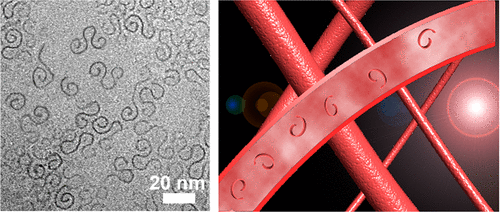当前位置:
X-MOL 学术
›
J. Am. Chem. Soc.
›
论文详情
Our official English website, www.x-mol.net, welcomes your feedback! (Note: you will need to create a separate account there.)
Biocompatibility of Magnetic Resonance Imaging Nanoprobes Improved by Transformable Gadolinium Oxide Nanocoil
Journal of the American Chemical Society ( IF 15.0 ) Pub Date : 2018-10-02 , DOI: 10.1021/jacs.8b08118 Dan Luo 1 , Shengjie Cui 2 , Yan Liu 2 , Chunyan Shi 3 , Qian Song 4 , Xiaoyun Qin 4 , Ting Zhang 2 , Zhenjie Xue 4 , Tie Wang 4
Journal of the American Chemical Society ( IF 15.0 ) Pub Date : 2018-10-02 , DOI: 10.1021/jacs.8b08118 Dan Luo 1 , Shengjie Cui 2 , Yan Liu 2 , Chunyan Shi 3 , Qian Song 4 , Xiaoyun Qin 4 , Ting Zhang 2 , Zhenjie Xue 4 , Tie Wang 4
Affiliation

|
To design functional nanomaterials for biomedical applications, the challenge for scientists is to gain further understanding of their unique toxicological properties. Nonspecific adhesion of proteins and endocytosis are considered to be the major biotoxic sources of imaging nanoprobes. Here, we fabricated ultrathin gadolinium oxide (Gd2O3) nanocoils with a low Young's modulus, which provides transformable properties in solution. The spatial configurational freedom of ultrathin nanocoils induces the steric repulsion to the nonspecific adsorption of proteins that, in turn, suppresses cellular uptake and thus improves their biocompatibility. The larger number of exposed surface gadolinium atoms of the ultrathin nanocoils provided enhanced T1 magnetic resonance (MR) imaging contrast with high signal activation. Such nanocontrast agents were applied to in vivo MR bioimaging to achieve prolonged circulation lifetime. The improved biocompatibility by transformable Gd2O3 nanocoils could open up a new perspective toward the design and construction of various nano-biomedicines in the future.
中文翻译:

可转化氧化钆纳米线圈改善磁共振成像纳米探针的生物相容性
为了设计用于生物医学应用的功能性纳米材料,科学家面临的挑战是进一步了解其独特的毒理学特性。蛋白质的非特异性粘附和内吞作用被认为是成像纳米探针的主要生物毒性来源。在这里,我们制造了具有低杨氏模量的超薄氧化钆 (Gd2O3) 纳米线圈,可在溶液中提供可转换的特性。超薄纳米线圈的空间构型自由诱导了对蛋白质非特异性吸附的空间排斥,进而抑制了细胞摄取,从而提高了它们的生物相容性。超薄纳米线圈的大量暴露表面钆原子提供增强的 T1 磁共振 (MR) 成像对比度和高信号激活。这种纳米造影剂被应用于体内 MR 生物成像,以实现延长的循环寿命。可转化的 Gd2O3 纳米线圈改善的生物相容性可以为未来各种纳米生物药物的设计和构建开辟新的视角。
更新日期:2018-10-02
中文翻译:

可转化氧化钆纳米线圈改善磁共振成像纳米探针的生物相容性
为了设计用于生物医学应用的功能性纳米材料,科学家面临的挑战是进一步了解其独特的毒理学特性。蛋白质的非特异性粘附和内吞作用被认为是成像纳米探针的主要生物毒性来源。在这里,我们制造了具有低杨氏模量的超薄氧化钆 (Gd2O3) 纳米线圈,可在溶液中提供可转换的特性。超薄纳米线圈的空间构型自由诱导了对蛋白质非特异性吸附的空间排斥,进而抑制了细胞摄取,从而提高了它们的生物相容性。超薄纳米线圈的大量暴露表面钆原子提供增强的 T1 磁共振 (MR) 成像对比度和高信号激活。这种纳米造影剂被应用于体内 MR 生物成像,以实现延长的循环寿命。可转化的 Gd2O3 纳米线圈改善的生物相容性可以为未来各种纳米生物药物的设计和构建开辟新的视角。

























 京公网安备 11010802027423号
京公网安备 11010802027423号